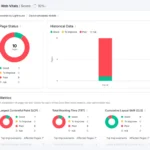
Introduction
In the fast-evolving digital world of 2026, creating viral content isn’t about random luck — it’s about blending data analytics, SEO strategies, and audience psychology.
Every minute, thousands of posts flood the internet. To rise above the noise, you need content that’s not only shareable but also discoverable through search engines.
In this article, we’ll explore how you can use SEO data, analytics, and AI tools to create viral content that consistently attracts, engages, and converts your audience in 2026.
1. The New Meaning of “Viral Content” in 2026
Gone are the days when virality meant just millions of views. In 2026, true virality combines:
- Sustained engagement: Not just views — real interactions and shares.
- Long-term discoverability: Content that continues to rank through SEO.
- Cross-platform relevance: Works effectively across Google, YouTube, Instagram, LinkedIn, and TikTok.
🔑 Key Insight: Viral content today must have emotional appeal for social media and keyword depth for search engines. That’s the winning blend.
2. Start with Powerful SEO & Data Research
Every viral idea begins with data.
Instead of guessing what might work, use SEO analytics to understand what your audience is already searching for.
Tools for Data-Driven Research:
- Google Keyword Planner – Find search volumes and keyword competitiveness.
- Ahrefs / SEMrush – Analyze what’s ranking in your niche and spot keyword gaps.
- Google Trends – Discover what’s trending and predict upcoming waves.
- BuzzSumo – Identify which types of content perform best on social platforms.
- AnswerThePublic – Uncover common questions your audience wants answered.
🧠 Smart Tip: Combine search volume data with social engagement data. For example, if “AI content tools” are trending on TikTok and have a high search volume on Google — that’s your viral topic opportunity.
3. Map Your SEO Strategy Before CreatingOnce you’ve found a promising topic, map out a SEO strategy before writing or filming.
SEO Strategy Blueprint:
- Choose a focus keyword (e.g., “viral content strategy 2026”).
- Pick 3–5 supporting keywords (e.g., “SEO for viral content”, “data-driven marketing”).
- Create a search-intent outline — structure your blog or video around what users expect to find.
- Plan internal and external links for SEO strength.
This foundation ensures your content is not only interesting but also algorithm-friendly.
4. Craft Emotionally Intelligent & Search-Optimized Content
Virality depends on emotion. SEO ensures discoverability. Combine both for maximum impact.
Emotional Triggers That Work Best:
- Awe & Inspiration: Case studies or stories of success.
- Surprise: Unexpected data insights or new perspectives.
- Humor & Relatability: Light, shareable content that feels human.
- Empathy: Human-centered storytelling that builds connection.
When using these triggers, weave in keywords naturally.
For example:
“Here’s a data-driven SEO strategy that helped our content go viral in under 7 days.”
This keeps your content both emotionally appealing and keyword-optimized.
5. Optimize for Every Platform’s SEO Algorithm
Each digital platform has its own “SEO language.” Customize your approach accordingly:
| Platform | Optimization Focus | Tactics for 2026 |
|---|---|---|
| Google / Blogs | Keywords, backlinks, dwell time | Use schema markup, LSI keywords, and 1200+ words of quality content. |
| YouTube | Watch time, CTR, keywords | Optimize titles, thumbnails, and transcriptions with keywords. |
| Instagram & TikTok | Hashtags, engagement, watch rate | Combine trending audio + keyword hashtags (#SEO2026, #ViralMarketing). |
| Thought leadership & readability | Use data-driven storytelling with clear value insights. |
Pro Tip: Repurpose one high-performing blog into multiple SEO-optimized snippets for different platforms — maximizing reach.
6. Measure and Refine Through Analytics
After publishing, analyze your performance to understand what truly works.
Key Metrics to Track:
- CTR (Click-Through Rate): How many users clicked your title.
- Engagement Rate: Likes, shares, comments.
- Average Watch Time / Dwell Time: How long people stayed.
- Keyword Ranking Changes: Use Google Search Console or Ahrefs.
Based on these insights:
- Update titles if CTR is low.
- Refresh old posts with new data and updated keywords.
- Repost high-performing topics with fresh visuals.
Remember, continuous optimization turns short-term virality into long-term visibility.
7. Use AI & Automation to Supercharge SEO and Virality
AI is transforming how creators optimize content in 2026. These tools simplify research, writing, and ranking:
Best AI Tools for Content in 2026:
- ChatGPT / Jasper AI: Draft keyword-rich captions and blogs.
- Surfer SEO / Clearscope: Optimize on-page content for ranking.
- Canva Magic Studio: Design high-quality, shareable visuals fast.
- VidIQ / TubeBuddy: Discover viral video keywords and analytics.
AI doesn’t replace creativity — it amplifies it. Use it to find data, test titles, and perfect your strategy.
8. Build Backlinks & Social Signals
Viral and SEO content both need strong distribution signals.
Ways to Strengthen Your Reach:
- Guest blogging on high-domain sites.
- Collaborations with influencers or industry experts.
- Embedding content in newsletters or LinkedIn articles.
- Encouraging user-generated content (UGC) through challenges or polls.
The more your content is referenced and shared, the higher your authority grows in both SEO and social algorithms.
Our Services SEO Services in Madhapur | SEO Services in Ameerpet | SEO Services in Hitech-city | SEO Services in Azamgarh
Conclusion
Creating viral content in 2026 isn’t magic — it’s a strategic mix of SEO, analytics, and creativity.
By studying trends, optimizing your keywords, understanding audience emotions, and leveraging AI, you can craft content that ranks high, spreads fast, and continues to deliver traffic for months.
✨ Remember:
- Data shows you what people want.
- SEO helps them find it.
- Emotion makes them share it.
Master these three — and you’ll
FAQs
1. What role does data play in creating viral content?
Data helps identify trending topics, audience preferences, and optimal posting times. By analyzing engagement metrics and search trends, you can create content that resonates with your audience and has a higher chance of going viral.
2. Can SEO make content more likely to go viral?
Yes. SEO ensures your content is discoverable through search engines. By optimizing keywords, meta descriptions, headings, and internal linking, your content can reach a larger audience, increasing its viral potential.
3. How do I identify topics that are likely to go viral?
Use tools like Google Trends, BuzzSumo, Ahrefs Content Explorer, and social listening platforms to find high-engagement topics. Look for content that has a combination of high shares, search volume, and audience relevance.
4. How long should content be to maximize virality and SEO?
Long-form content (1,500–3,000+ words) with in-depth analysis often performs well in SEO and sharing. However, short, highly visual, or emotionally engaging content (videos, infographics, lists) can also go viral depending on the platform and audience.
5. How can social sharing data inform content strategy?
Analyzing which posts get the most shares, likes, and comments helps you understand audience interests. You can then replicate formats, topics, or styles that resonate most to increase the chances of virality.
6. What role does timing play in viral content creation?
Publishing content when your target audience is most active on search engines and social platforms increases initial engagement, which is crucial for virality. Data analytics can reveal peak times for maximum reach.
7. Can visuals improve the chances of content going viral?
Absolutely. Infographics, videos, charts, and memes capture attention faster than plain text. Optimizing these visuals with SEO-friendly alt text and descriptions can enhance both virality and search visibility.
8. How do I track if content is going viral?
Track metrics like social shares, backlinks, organic traffic growth, engagement rates, and mentions using tools like Google Analytics, BuzzSumo, or social media dashboards. Sudden spikes often indicate viral performance.
9. How does keyword optimization influence viral content?
Targeting trending and relevant keywords ensures your content appears in search results for popular queries, helping it gain more visibility. Combining SEO with shareable content elements increases the chance of virality.
10. Can emotional triggers in content boost virality?
Yes. Content that evokes strong emotions like happiness, surprise, awe, or inspiration is more likely to be shared. Data analytics can help identify which emotional triggers resonate most with your audience.





